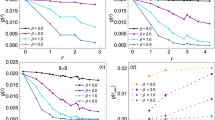Abstract
Nonchiral bosonization (NCBT) is a nontrivial modification of the standard Fermi—Bose correspondence in one spatial dimension done to facilitate studying strongly inhomogeneous Luttinger liquids where the properties of free fermions plus the source of inhomogeneities are reproduced exactly. We introduce the NCBT formalism and discuss limit case checks, fermion commutation rules, point-splitting constraints, etc. We expand the Green’s functions obtained from NCBT in powers of the fermion—fermion interaction strength (only short-range forward scattering) and compare them with the corresponding terms obtained using standard fermionic perturbation theory. Finally, we substitute the Green’s functions obtained from NCBT in the Schwinger—Dyson equation, which is the equation of motion of the Green’s functions and serves as a nonperturbative confirmation of the method. We briefly discuss some other analytic approaches such as functional bosonization and numerical techniques like the density-matrix renormalization group, which can be used to obtain the correlation functions in one dimension.
Similar content being viewed by others
References
S.-I. Tomonaga, “Remarks on Bloch’s method of sound waves applied to many-fermion problems,” Progr. Theor. Phys., 5, 544–569 (1950).
J. Luttinger, “An exactly soluble model of a many-fermion system,” J. Math. Phys., 4, 1154–1162 (1963).
D. C. Mattis and E. H. Lieb, “Exact solution of a many-fermion system and its associated boson field,” J. Math. Phys., 6, 304–312 (1965).
I. E. Dzyaloshinskii and A. I. Larkin, “Correlation functions for a one-dimensional fermi system with long-range interaction (Tomonaga model),” Sov. Phys. JETP, 38, 202–208 (1974).
K. B. Efetov and A. I. Larkin, “Correlation functions in one-dimensional systems with a strong interaction,” Sov. Phys. JETP, 42, 390–396 (1976).
F. D. M. Haldane, “‘Luttinger liquid theory’ of one-dimensional quantum fluids: I. Properties of the Luttinger model and their extension to the general 1D interacting spinless Fermi gas,” J. Phys. C, 14, 2585–2610 (1981).
T. Giamarchi, Quantum Physics in One Dimension (Intl. Ser. Monogr. Phys., Vol. 121), Oxford Univ. Press, Oxford (2004).
G. S. Setlur, Dynamics of Classical and Quantum Fields: An Introduction, CRC Press, Boca Raton, Fla. (2013).
J. P. Das and G. S. Setlur, “The quantum steeplechase,” Internat. J. Modern Phys. A, 33, 1850174 (2018); arXiv:1608.05826v5 [cond-mat.str-el] (2016).
C. Kane and M. P. Fisher, “Transport in a one-channel Luttinger liquid,” Phys. Rev. Lett., 68, 1220–1223 (1992).
A. Schwartz, M. Dressel, G. Gruner, V. Vescoli, L. Degiorgi, and T. Giamarchi, “On-chain electrodynamics of metallic (TMTSF)2 X salts: Observation of Tomonaga–Luttinger liquid response,” Phys. Rev. B, 58, 1261–1271 (1998); arXiv:cond-mat/9801198v3 (1998).
M. Bockrath, D. H. Cobden, J. Lu, A. G. Rinzler, R. E. Smalley, L. Balents, and P. L. McEuen, “Luttinger-liquid behaviour in carbon nanotubes,” Nature, 397, 598–601 (1999); arXiv:cond-mat/9812233v1 (1998).
O. Auslaender, A. Yacoby, R. De Picciotto, K. Baldwin, L. Pfeiffer, and K. West, “Experimental evidence for resonant tunneling in a Luttinger liquid,” Phys. Rev. Lett., 84, 1764–1768 (2000).
J. P. Das and G. S. Setlur, “The one step fermionic ladder,” Phys. E, 94, 216–230 (2017); arXiv:1704.01710v4 [cond-mat.str-el] (2017).
J. P. Das and G. S. Setlur, “Ponderous impurities in a Luttinger liquid,” Europhys. Lett., 123, 27002 (2018); arXiv:1709.06728v3 [cond-mat.mes-hall] (2017).
F. J. Dyson, “The S matrix in quantum electrodynamics,” Phys. Rev., 75, 1736–1755 (1949).
J. Schwinger, “On the Green’s functions of quantized fields: I,” Proc. Nat. Acad. Sci. USA, 37, 452–455 (1951).
H. C. Fogedby, “Correlation functions for the Tomonaga model,” J. Phys. C, 9, 3757–3773 (1976).
D. K. K. Lee and Y. Chen, “Functional bosonisation of the Tomonaga–Luttinger model,” J. Phys. A: Math. Gen., 21, 4155–4171 (1988).
V. I. Fernández and C. M. Naon, “Friedel oscillations in a Luttinger liquid with long-range interactions,” Phys. Rev. B, 64, 033402 (2001).
I. V. Lerner, B. L. Althsuler, V. I. Fal’ko, and T. Giamarchi, eds., Strongly Correlated Fermions and Bosons in Low-Dimensional Disordered Systems (NATO Sci. Ser., Vol. 72), Springer, Dordrecht (2002).
U. Schollwöck, “The density-matrix renormalization group,” Rev. Modern Phys., 77, 259–315 (2005); arXiv:cond-mat/0409292v1 (2004).
M. Stone, ed., Bosonization, World Scientific, Singapore (1994).
J. Eisert, “Entanglement and tensor network states,” arXiv:1308.3318v2 [quant-ph] (2013).
N. Bultinck, D. J. Williamson, J. Haegeman, and F. Verstraete, “Fermionic matrix product states and one-dimensional topological phases,” Phys. Rev. B, 95, 075108 (2017); arXiv:1610.07849v2 [cond-mat.str-el] (2016).
M. B. Hastings, “Entropy and entanglement in quantum ground states,” Phys. Rev. B, 76, 035114 (2007); arXiv:cond-mat/0701055v1 (2007).
F. Verstraete, V. Murg, and J. I. Cirac, “Matrix product states, projected entangled pair states, and variational renormalization group methods for quantum spin systems,” Adv. Phys., 57, 143–224 (2008); arXiv:0907.2796v1 [quant-ph] (2009).
M. B. Hastings, “An area law for one-dimensional quantum systems,” J. Stat. Mech., 2007, P08024 (2007).
M. Andersson, M. Boman, and S. Östlund, “Density-matrix renormalization group for a gapless system of free fermions,” Phys. Rev. B, 59, 10493–10503 (1999); arXiv:cond-mat/9810093v1 (1998).
Acknowledgments
The authors express deepest gratitude to the lead developer of the ITensor, E. Miles Stoudenmire, who has always been very helpful whenever approached with queries and doubts.
Author information
Authors and Affiliations
Corresponding author
Additional information
This research was supported in part by the Department of Science and Technology, Government of India (DST/SERC: SR/S2/CMP/46 2009).
Prepared from an English manuscript submitted by the authors; for the Russian version, see Teoreticheskaya i Matematicheskaya Fizika, Vol. 199, No. 2, pp. 302–329, May, 2019.
Rights and permissions
About this article
Cite this article
Das, J.P., Chowdhury, C. & Setlur, G.S. Nonchiral Bosonization of Strongly Inhomogeneous Luttinger Liquids. Theor Math Phys 199, 736–760 (2019). https://doi.org/10.1134/S0040577919050106
Received:
Revised:
Accepted:
Published:
Issue Date:
DOI: https://doi.org/10.1134/S0040577919050106




